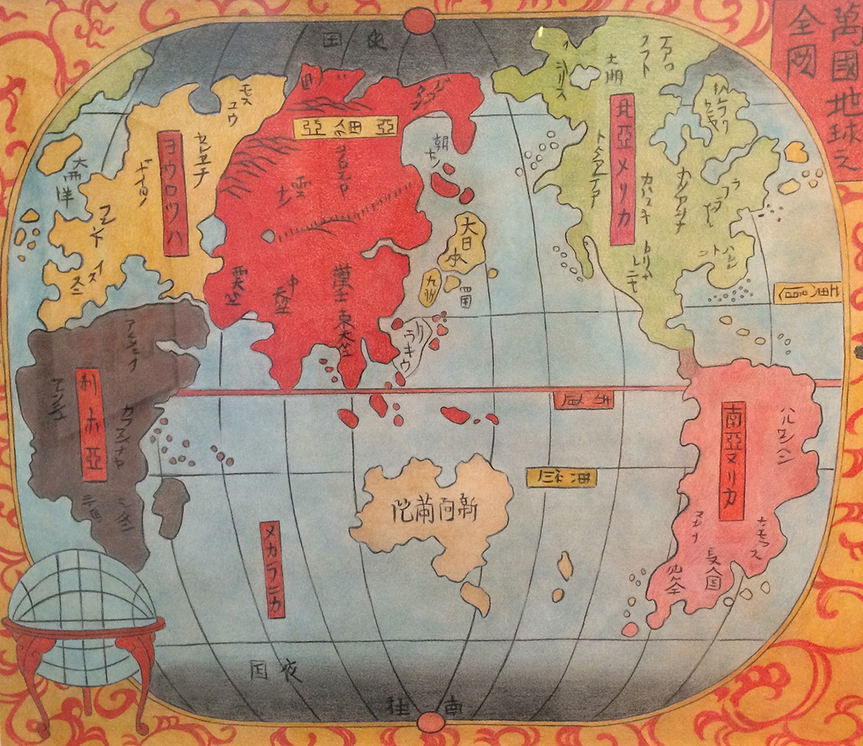SAM DURANT’s room in the Yokohama Museum of Art relayed the opposing perspectives of Japan and the United States during the late 19th century. It included found objects and paintings from the Yokohama Museum of Art’s permanent collection. 1853–1900, Map of the World, Japan Centered (2015) is a drawing based on a real historical map. All photos by Emily Wakeling for ArtAsiaPacific.
SHOOSHIE SULAIMAN’s Pulau Champaka, berbintang Syira, berpaksi Khatulistiwa (Champaca Island, the star of Sirius, on the axis of Equator) (2017), featuring hybrid Malaysian and Japanese trees and a Galapagos tortoise, positioned in front of AI WEIWEI’s monumental hang of inflatable life rafts, Reframe (2016).
JOKO AVIANTO’s gigantic woven sculpture The Border Between Good and Evil is Terribly Frizzy (2017) occupied the foyer of the Yokohama Museum of Art. As well as being a direct interpretation of “connectivity,” it created a physical gateway to the exhibition.
Artist duo MAP OFFICE led visitors up the stairs in the Yokohama Museum of Art with a number of installations and vitrines that interpret political and social issues as if they were islands. Domesticated Island (Japan) – Island of Fantasy (2017) is a miniature cosmos of an idyllic civilization, where balloons signify a chance to “start again” on new land.
ANNE SAMAT’s wall sculptures were given anthropomorphic names such as Tribal Chief Series 8 (2016). They are made from a collection of industrial objects but arranged in a way that references Malaysia’s traditional textiles.
NATSUMI SEO was given space in both of the Triennale’s largest venues—the Yokohama Museum of Art and the Yokohama Red Brick Warehouse No. 1—for her works based on memories of some who survived the 2011 Tohoku earthquake and tsunami, as well as elders who lived through World War II. Visiting what we can’t talk about (2017) uses watercolor landscapes and texts to convey their stories.
Printmaker SACHIKO KAZAMA has expanded into painting, as seen in a set of sliding doors titled Human Mt. Fuji (2017), which were displayed against the wall in the Yokohama Museum of Art.
“Don’t Follow the Wind” is an exhibition project located inside Fukushima’s radioactive contamination zone, and displayed virtually for the Yokohama Triennale. A Walk in Fukushima (2016–17) uses VR headsets that also provide audio commentary so that the Triennale’s visitors could see up-close the abandoned streets and houses that were devastated by the TEPCO Daiichi nuclear disaster.
SATORU AOYAMA is an artist whose practice channels the political philosophies of the British craftsman William Morris and his Arts and Crafts Movement. His artworks include black and silver embroidered portraits of famous women leaders: Christine Lagarde, Angela Merkel and Sarah Palin. The work at the back of the room reads: The waste of labour power would come to an end (2017).
SUSUMU KINOSHITA’s large but delicate drawings of aged and diseased bodies, including The Solitude of Light (2009), are isolated from context, placing them in the cross-section of brutal honesty and abjectness.
Since 2012, DONG YUAN has been painting objects from her grandmother’s demolished house and then installing the numerous canvases to recreate the home’s interior in true-to-life dimensions and scale. The illusion in Grandmother’s House – ancestors’ layer (2013) is impressive, seen most clearly in paintings of the posters on the fridge and fruit offered on the ancestral shrine.
TSUYOSHI OZAWA’s work continued his fictionalized histories of famous Japanese thinkers and artists. The Return of K.T.O. (2017) brings together text, video and painting for an account of late-19th-century art historian and philosopher Kakuzo “Tenshin” Okakura and his travels to India.
In Yokohama Red Brick Warehouse No. 1, Plywood Shinchi (2017), a set of kinetic sculptures and video by UJINO, had a generous amount of space to not only build a noise-chorus of household machines, but also to screen a documentary video about the former Tokyo training site for World War II kamikaze pilots to a curious and lingering audience.
Strong offerings in Yokohama art gallery BankART Studio NYK’s exhibition programming and the Koganecho Bazaar 2017 coincided with the Yokohama Triennale this year. The former was filled with substantial works from emerging Japanese artists, such as KOHEI SEKIGAWA’s performance and installation on the space’s third floor.
Although YUKINORI YANAGI’s artwork occupied its own space in the basement of the 100-year-old Yokohama Port Opening Memorial Hall, away from all other artworks presented in the Triennale, it was arguably the most important offering in the entire program. Project God-zilla: The Basement of Yokohama Port Opening Memorial Hall (2017) and its surrounding rooms were designed to put the viewer in the position of a nuclear blast survivor, with the opportunity to reflect on how the world ended up in this state.




